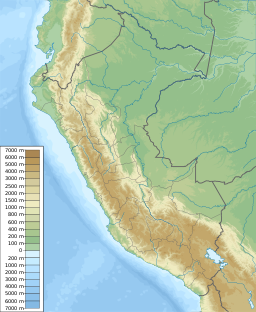Lake Lagunillas is a lake in the Andes of far southeastern Peru. Lagunillas is at an altitude of about 4,250 m (13,900 ft) and it is located just northwest of Lake Saracocha. These two lakes are part of the system drained by the Coata River, which flows in a generally easterly direction until entering westernmost Lake Titicaca, about 50 km (30 mi) from Lake Lagunillas as the crow flies.[1][2]
| Lake Lagunillas | |
|---|---|
 The lake Lagunillas with the Sillapaka mountain range in the background (on the left). | |
| Location | Puno Region |
| Coordinates | 15°43′30″S 70°44′08″W / 15.725°S 70.735556°W |
| Basin countries | Peru |
| Surface elevation | c. 4,250 m (13,900 ft) |
In 2014, the pupfish Orestias luteus made up slightly more than 70% of catches in fisheries, with the remaining being the introduced rainbow trout, a species also farmed in the lake.[3] Lake Lagunillas is home to the unusual and relatively large "escomeli" form of the Titicaca water frog.[1]
Climate
edit| Climate data for Lake Lagunillas, elevation 4,200 m (13,800 ft) | |||||||||||||
|---|---|---|---|---|---|---|---|---|---|---|---|---|---|
| Month | Jan | Feb | Mar | Apr | May | Jun | Jul | Aug | Sep | Oct | Nov | Dec | Year |
| Mean daily maximum °C (°F) | 13.8 (56.8) |
13.8 (56.8) |
13.5 (56.3) |
14.2 (57.6) |
14.0 (57.2) |
13.2 (55.8) |
13.2 (55.8) |
14.1 (57.4) |
15.2 (59.4) |
16.2 (61.2) |
16.4 (61.5) |
15.2 (59.4) |
14.4 (57.9) |
| Daily mean °C (°F) | 7.6 (45.7) |
7.6 (45.7) |
7.4 (45.3) |
7.1 (44.8) |
5.6 (42.1) |
4.1 (39.4) |
4.0 (39.2) |
4.7 (40.5) |
6.2 (43.2) |
7.3 (45.1) |
7.9 (46.2) |
7.8 (46.0) |
6.4 (43.6) |
| Mean daily minimum °C (°F) | 1.2 (34.2) |
1.3 (34.3) |
1.3 (34.3) |
−0.1 (31.8) |
−2.8 (27.0) |
−5.0 (23.0) |
−5.2 (22.6) |
−4.8 (23.4) |
−2.9 (26.8) |
−1.7 (28.9) |
−0.7 (30.7) |
0.4 (32.7) |
−1.6 (29.1) |
| Average precipitation mm (inches) | 163 (6.4) |
139 (5.5) |
114 (4.5) |
41 (1.6) |
9 (0.4) |
3 (0.1) |
2 (0.1) |
7 (0.3) |
13 (0.5) |
27 (1.1) |
51 (2.0) |
97 (3.8) |
666 (26.3) |
| Average relative humidity (%) | 63 | 63 | 62 | 53 | 46 | 45 | 44 | 43 | 42 | 42 | 46 | 52 | 50 |
| Source: Plataforma digital única del Estado Peruano[4] | |||||||||||||
See also
editReferences
edit- ^ a b Vellard, J. (1992). "The Amphibia". In C. Dejoux; A. Iltis (eds.). Lake Titicaca: a synthesis of limnological knowledge. Kluwer Academic Publishers. pp. 449–557. ISBN 0-7923-1663-0.
- ^ IMARPE; PELT (2014). "Monitoreo ecológico y limnológico de la Laguna de Lagunillas, Lampa - Puno (Convenio IMARPE-PELT)". IMARPE - Laboratorio Continental de Puno. 1: 1–53. doi:10.13140/RG.2.1.1592.6004.
- ^ "PLAN DIRECTOR GLOBAL BINACIONAL DE PROTECCION - PREVENCION DE INUNDACIONES V APROVECHAMIENTO DE LOS RECURSOS DEL LAGO TITICACA, RIO DESAGUADERO, LAGO POOPO V LAGO SALAR E COIPASA (SISTEMA T.D.P.S.) ESTUDIO DE CLIMATOLOGIA" (PDF). The European Commission (EC). Archived from the original (PDF) on 11 June 2024. Retrieved 11 June 2024.
- INEI, Compendio Estadistica 2007, page 26
